Service for Community Change: Recruiting Mental Health Professionals of Color
- Global Health
- Sustainable Development

In the Spring of 2021, Transdisciplinary ArtCenter students were challenged to co-create with Knowledge Partner Homeboy Industries to develop comprehensive, effective and low-cost campaign strategies that will lead to better recruitment outcomes for a more diverse pool of mental health professionals who can serve the Homeboy community as volunteers. Mental health is a national issue especially during the pandemic, and mental health among people of color a particular concern. Homeboy Industries, an organization that sees mental health as central to their work, could develop and leverage the Homeboy Heals brand to encourage overall stronger connections within communities of color that could appeal and increase volunteer signups and retention.
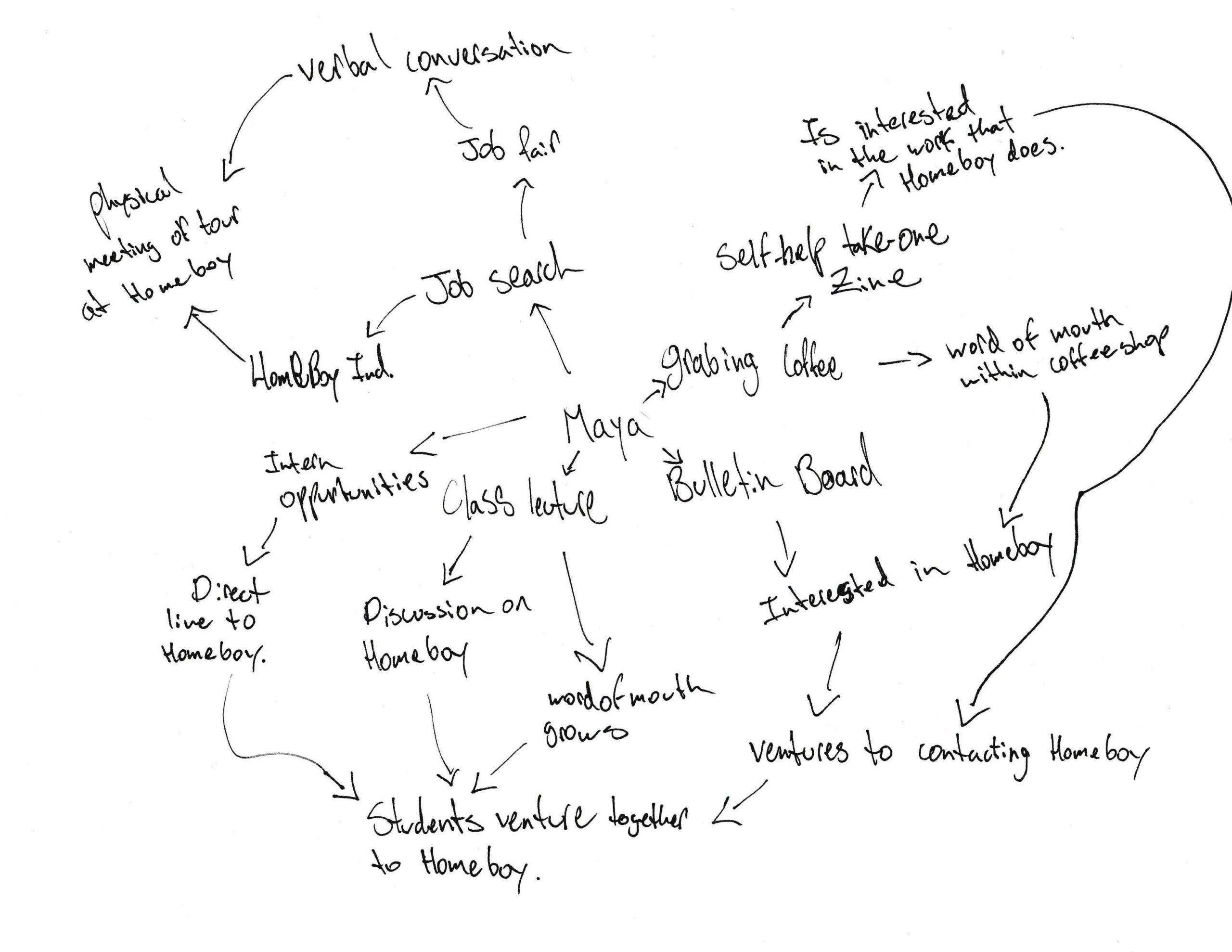
“It was really nice to have the check-ins for research and the gentle pushes. Research is always a part of my discipline but it’s nice to be reminded to think back on it. My favorite part was having the support in many different ways – from the professors, Designmatters, Homeboy. It was nice to feel that this was a team effort in our little group.”
Madison Vucci, ArtCenter Graduate Graphic Design student
Project Brief
Co-creating with Knowledge Partner Homeboy Industries, ArtCenter students were challenged to develop effective, low-cost and comprehensive campaign strategies to recruit more diverse mental health professionals who can serve the Homeboy community as volunteers. Additionally, a focus on the Homeboy Heals brand and these strategic outreach systems could also be used to build awareness and strong volunteer pipelines throughout communities of color.
Through research, interviews and immersion, students developed concepts, co-created with Homeboy Heals and presented thoughtful and diverse solutions that could be economical, effective and long-lasting.
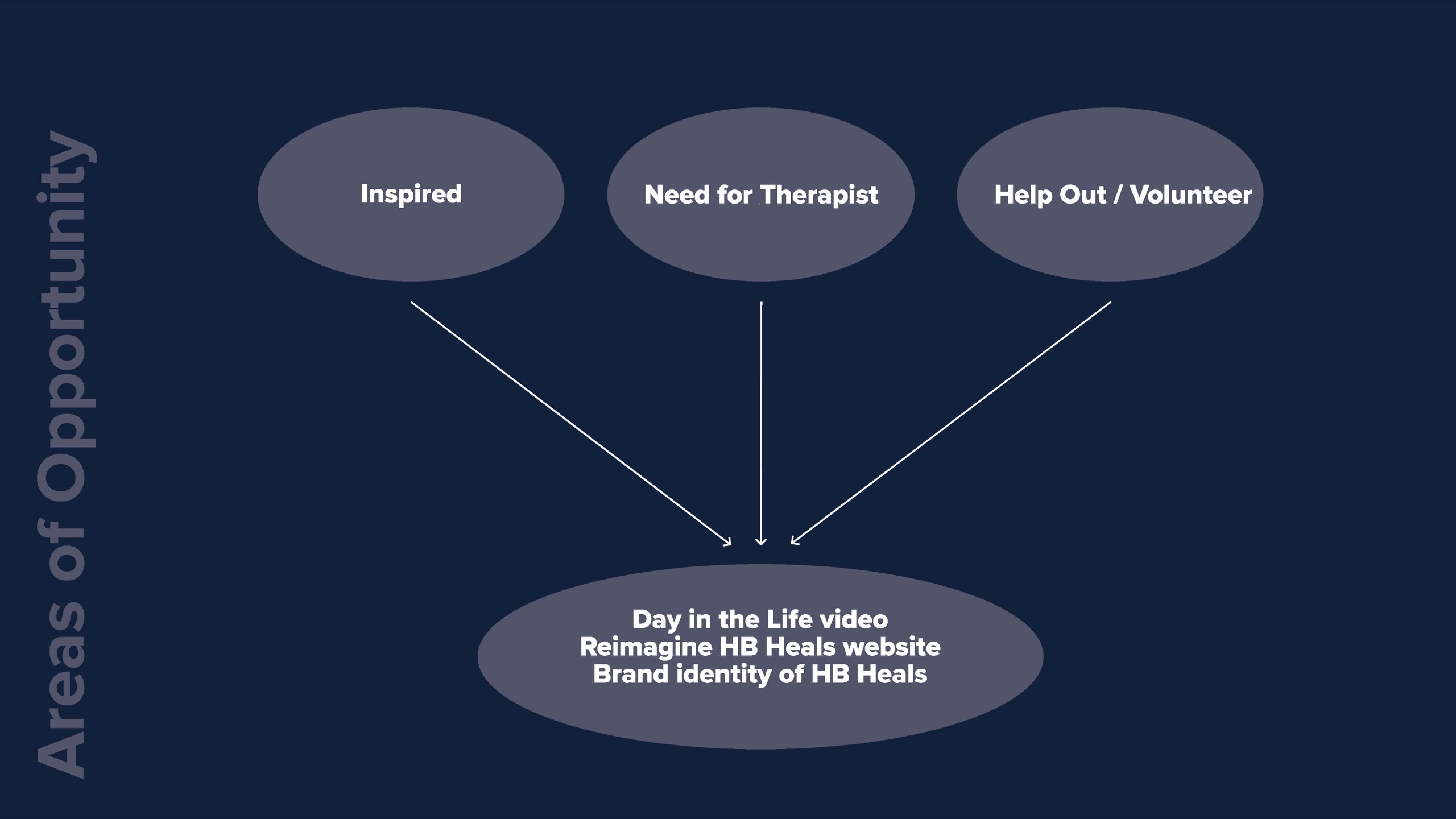
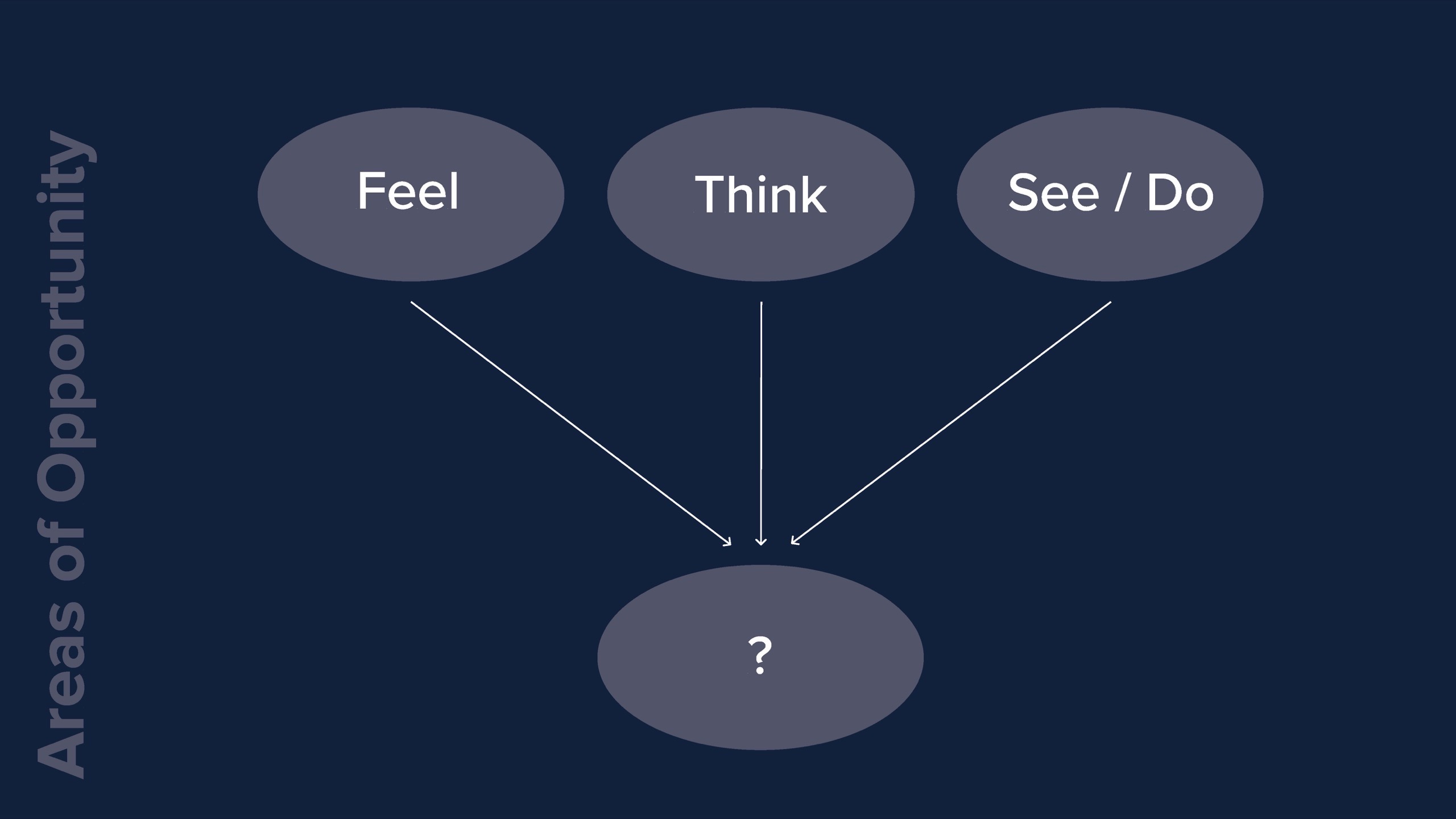
“When you can engage us and keep us wrapped in attention as you walk us through the concept hand-in-hand; that is where you win in presentations – and you did just that.”
Kat Carrido Bonds, Marketing Director, Homeboy Industries
About Homeboy Industries
Founded in 1992 and based in downtown Los Angeles, Homeboy Industries provides hope, training and support to formerly gang-involved and previously incarcerated men and women, helping them redirect their lives as contributing community members.
Through Homeboy’s 18-month program, participant/trainees learn new employable skills, job training and self-empowering identities.
Homeboy offers kinship, open dialogue and the “holiness of second chances.” Even though Homeboy was founded by Jesuit Father Greg Boyle, the program is not religious-specific, but rather stresses how individuals come broken and struggling to Homeboy and through the power of hope, hard work, and community support they find a way to change their lives. Homeboy trainees come from various scenarios: those with felony records, escaping gang culture, previously incarcerated, battling alcohol and drug addiction, young parents struggling with duties of adulthood.
Many find work in Homeboy’s bakeries, kitchens, IT asset recovery and electronics recycling programs. Trainees find helpful resources and services (tattoo removal, parenting classes, anger management, etc.) along with group and one-on-one mental health therapies which allow time and space to thoughtfully reexamine and reclaim their lives.
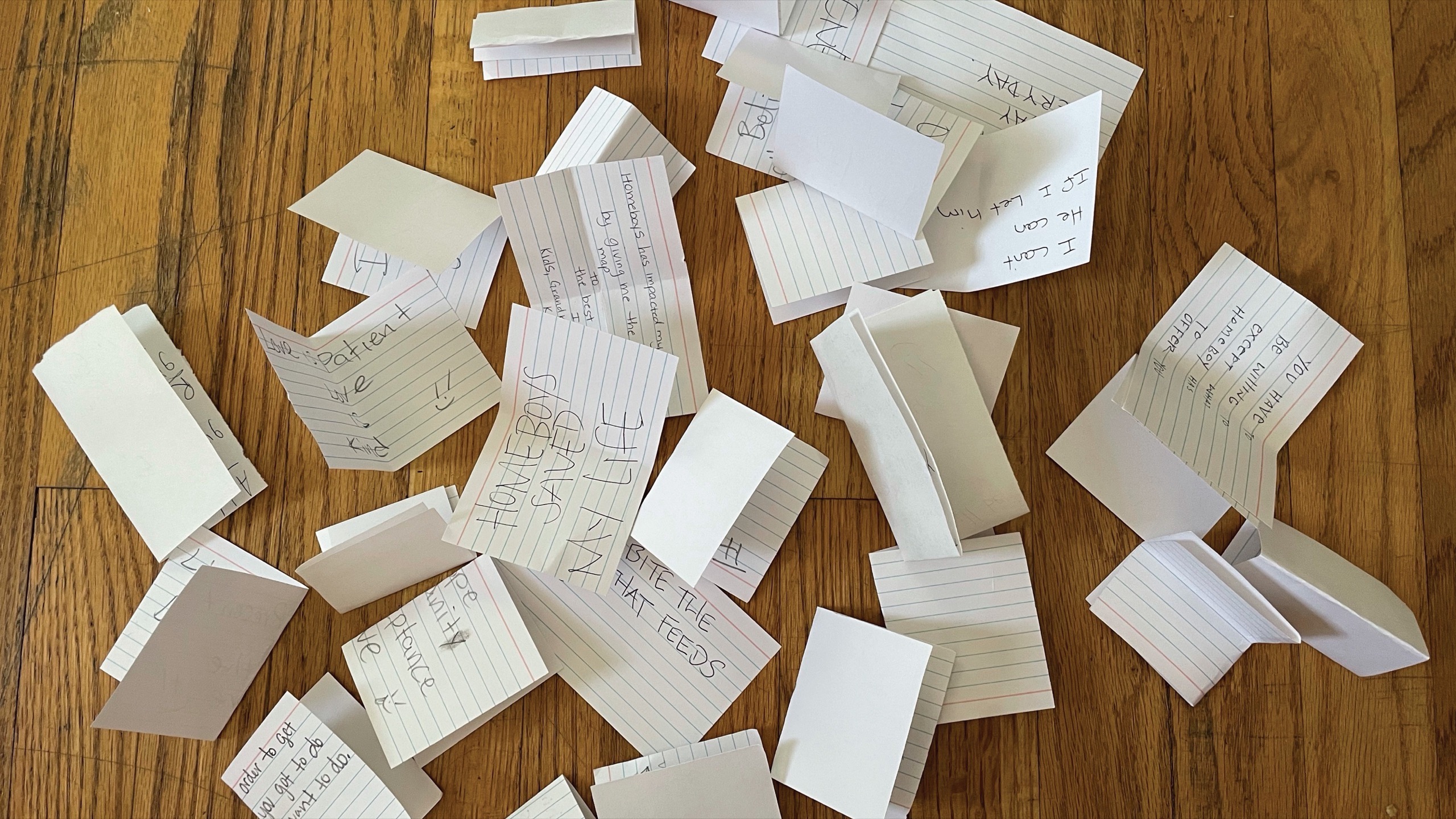
“In the beginning, I was nervous, because we’re in a pandemic and we’re in mental health at Homeboy Industries. But everyone – the staff and students — were very respectful and understanding and willing and creative about how to work with all of this. I appreciate all that went into this process. I’m gushing because finally mental health is at the center, it’s got the spotlight.”
Fajima Bedran, Director of Mental Health Services, Homeboy Industries
Research and Project Development
At the virtual session kickoff, students introduced themselves by sharing a recent project they worked on by describing what they learned from conceptualizing and executing their design ideas.
Panelists from Homeboy provided an overview of Homeboy Industries detailing the programs and various outreach methods they use to attract trainee participants as well as the numerous other volunteers who give their time and talent as service to the community.
ArtCenter students heard from a variety of speakers: panelists who shared their personal volunteer experiences and their journey to Homeboy Heals; students in a prior DesignJam that involved Homeboy Heals offered their insights from their experiences; and Pacific Oaks University Professor Carlene O. Fider who provided deeper context on mental health issues among minority racial/ethnic groups.
Students then learned more about Homeboy Heals which started in 2011 to address the psychological needs of program trainees. Volunteer licensed therapists work with Homeboy clients as they go through the 18-month program; the program started as a word-of-mouth networking; the therapists commit to one year working with Homeboy clients.
Therapy sessions are typically held at Homeboy; during the pandemic, however, those meetings moved to a virtual platform but have been greatly reduced. Students learned that Covid-19 created additional stresses and crisis situations for many clients.
Since Homeboy trainees are mainly Black and Latino, panelists explained that having more BIPOC therapists could encourage more participation and cultural familiarity; however investing the time for recruitment outreach has been challenging for the staff.
In Zoom-based breakout rooms, students probed panelists about the Homeboy model, the volunteer process and specifically how therapists are incorporated into the program.
After the breakout session, students regrouped and shared insights that provided directions for upcoming research opportunities: What motivates professionals to volunteer their services? What are the barriers to volunteering? Can there be some kind of compensation offered to these volunteers? Do they need to be local? How can the business ventures of Homeboy (Homegirl Café, etc.) support and help the mental health program?
For the duration of the studio, students were divided into three teams. Class assignments provided concept directions for teams to consider as they conducted research. Mapping out the volunteer application journey revealed the main steps of Entice, Enter, Engage, Exit and Extend; students wondered how at every step can the volunteer feel welcomed, supported, needed and valued?
Teams reached out to Homeboy personnel and gathered information from a variety of subject matter experts. They heard from UCLA BIPOC students studying to be mental health professionals who offered insights into the career landscape and how volunteering could play a role. Teams learned about engaging with hard-to-reach audiences from a marketing professional, and how other organizations recruited BIPOC mental health therapists.
Finally, student teams visited Homeboy Industries Headquarters (socially distanced) which provided a deeper understanding of the unique community and kinship that permeates the campus.
Initial Research Discoveries
At Week Four, teams presented their initial research discoveries to Homeboy representatives and mental health and education stakeholders. Feedback was critical at this point for teams to move forward with their campaign ideation.
Teams generated specific research questions, constructed case study persona profiles of BIPOC therapists, examined key pain points, and brainstormed areas of opportunities. Looking ahead to their campaign concepts, teams also presented possible design directives, branding ideas and offered overall takeaways and their next level of research.
Teams examined the current website platform, considered how to capture the inspirational Homeboy spirit in their designs, offered alternatives to word-of-mouth/posting flyers outreach, and delved into the diversity makeup of mental health workers (which is mostly white) as well as the pros and cons of younger vs older therapists.
Teams presented their brainstorming opportunities that involved extending social media reach, creating a support group for mental health workers, streamlining the volunteer application process, creating storytelling videos (clients and therapists sharing personal stories), developing an inspirational podcast and designing the Homeboy Heals brand.
Homeboy representatives and stakeholders offered candid feedback, explaining why some ideas wouldn’t be cost-effective or logistically feasible; they were excited by some possible concepts, (“I never would have thought of that!”) which encouraged teams to push forward in their ideation. Teams realized that the next phase of research would include a deeper look at mental health workers, how they can be found and what would encourage them to respond. What emotional connection must there be for a professional to fill out an online application and make a commitment?
Concept Development; Midterm Presentations
At midterm, teams once again connected with Homeboy representatives and other stakeholders, presenting their research, personas, insights and analysis along with concept proposals. This valuable feedback allowed student teams to pivot, amplify or discard their concepts.
Teams shared demographics of therapists, revealing that a small percentage are BIPOC. Overwhelmingly, because the profession is white dominated, the target audience is a very specific group of people which could be limiting.
Teams addressed using students or new graduates as volunteer therapists, citing that Homeboy clients are an extremely vulnerable population and require established experienced therapists to safely guide them. However, the importance of having volunteers who have the “Lived Experience” can be instrumental in helping others navigate new territories.
In analyzing their insights/research, teams saw the value of creating an emotional connection through storytelling, images and wording which can be done as podcasts or individual short videos that could be posted on various platforms such as Instagram Stories and YouTube. Students stressed that these avenues would make sure not to “exploit” clients or therapists, but rather capture the inspirational appeal and essence of Homeboy. Creating partnerships with influencers could be mutually beneficial.
Citing opportunities on the main Homeboy website, teams offered various approaches to redesigning pages, enhancing the Homeboy Heals presence and integrating the volunteer experience throughout the main website’s landing page.
Each team received detailed constructive feedback; these options and suggestions gave the students specific directions on how to refine their concepts, what they still needed to do and how to incorporate the needs of Homeboy Industries into their final proposals.
Refinement & Production
For the remainder of the studio, teams worked on incorporating the feedback, co-creating with the Homies and their audience, broadening their approach and making final design decisions – all the while seeking to strike the right “Homeboy” vibe in their campaigns.
Teams continued to collaborate with Homeboy personnel, including marketing and social media representatives about current and future branding as well as communications directions.
Students constantly questioned if their approach was making the correct inspirational appeal, folding in comments and suggestions from interviews and research.
Finally, students considered how to make their projects budget-friendly and easy to implement while still retaining the big vision of outreach. Teams also developed an overview of implementation for their campaigns, how elements would be rolled out and other touchpoints needed in making their vision a reality.
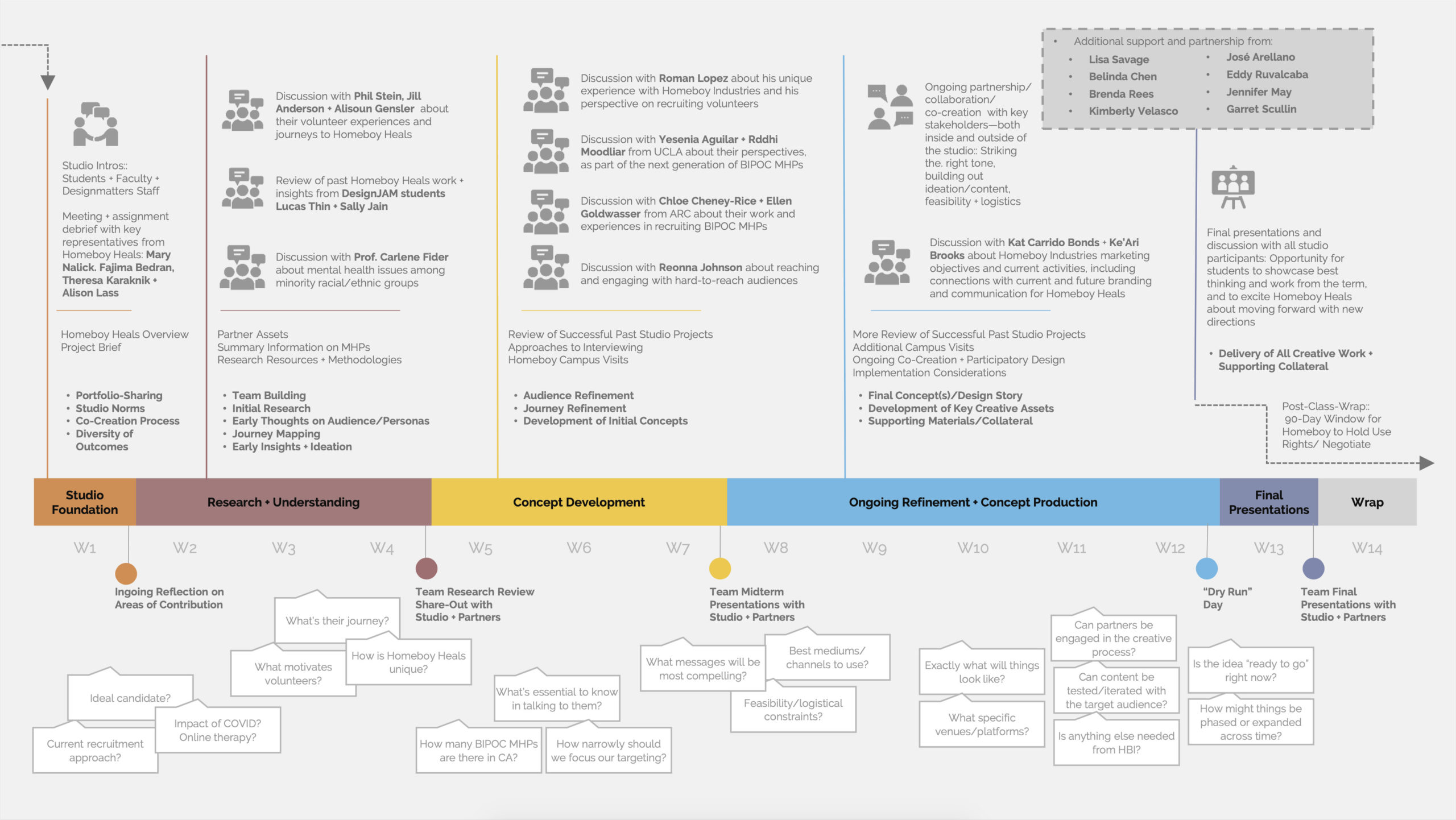
Outcomes
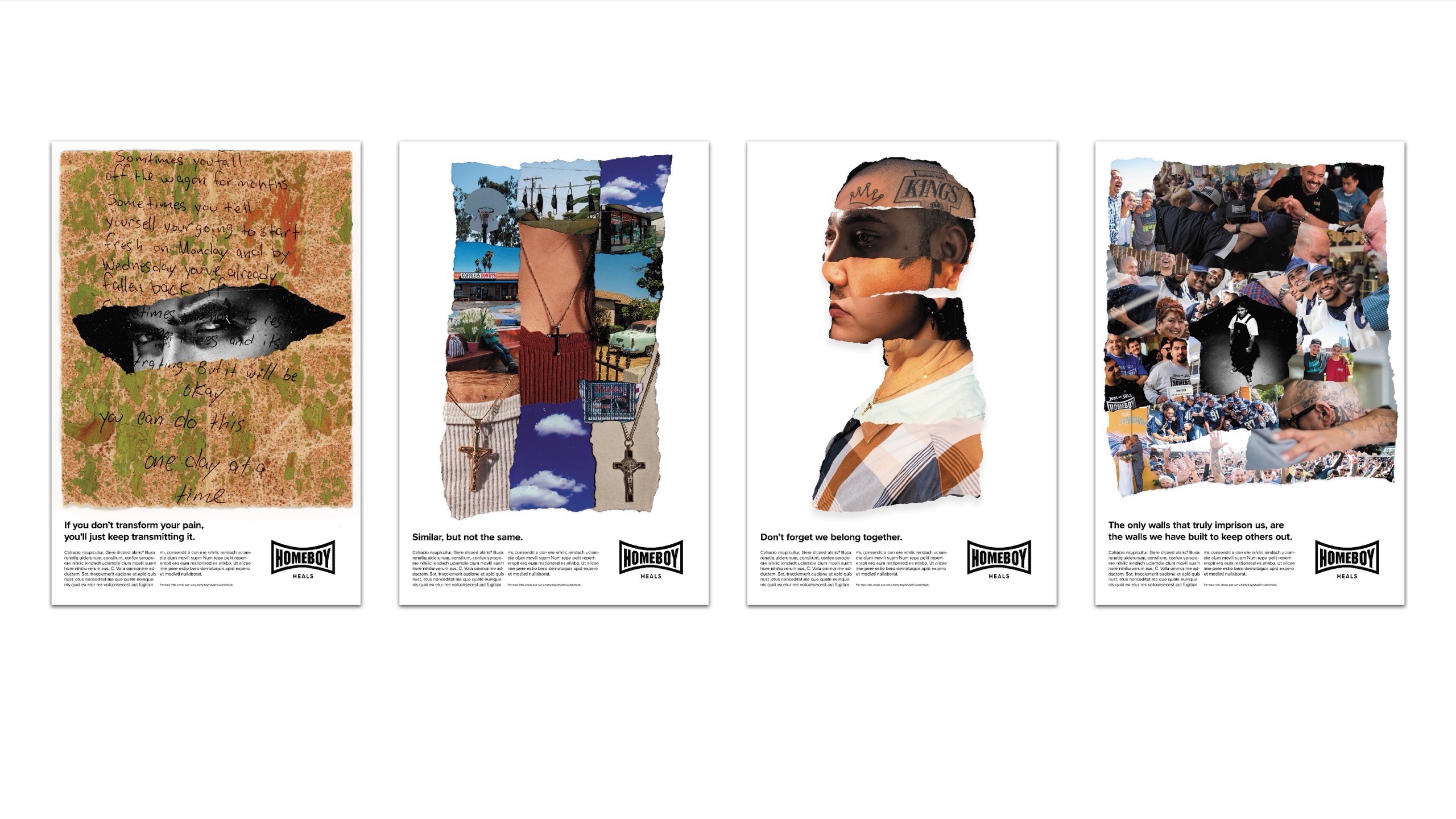 close
close
Team Sacci
Read moreSaul Barrera, Madison Vucci
Realizing the importance of word-of-mouth outreach within certain social bubbles, this approach features a zine publication and a city-wide Awareness Campaign of Homeboy Heals.
A collage aesthetic would permeate the zine; ripped and replaced photo images reflect the complex life of a Homeboy trainee. The publication would promote Homeboy Industries to the general public offering an overview with information and education with beautiful engaging art. To “plant the seed” for future therapists to consider volunteering at Homeboy Heals, the zine would be distributed freely around college campuses, especially UCLA’s cafes, student gatherings and other high-trafficked areas.
The zine could also contain images that depict the daily kinship, connection and support found at Homeboy by trainees who snapped photos about their day-to-day activities with disposable cameras. Additionally, trainees jotted down simple phrases and concepts about what Homeboy means to them which were collected in a central onsite location; these images and quotes can be used in the zine.
The Awareness Campaign expands the zine imagery into eye-catching posters that can be strategically placed into key neighborhoods in the city on bus benches, sides of buildings, cafes, and other high-trafficked areas.
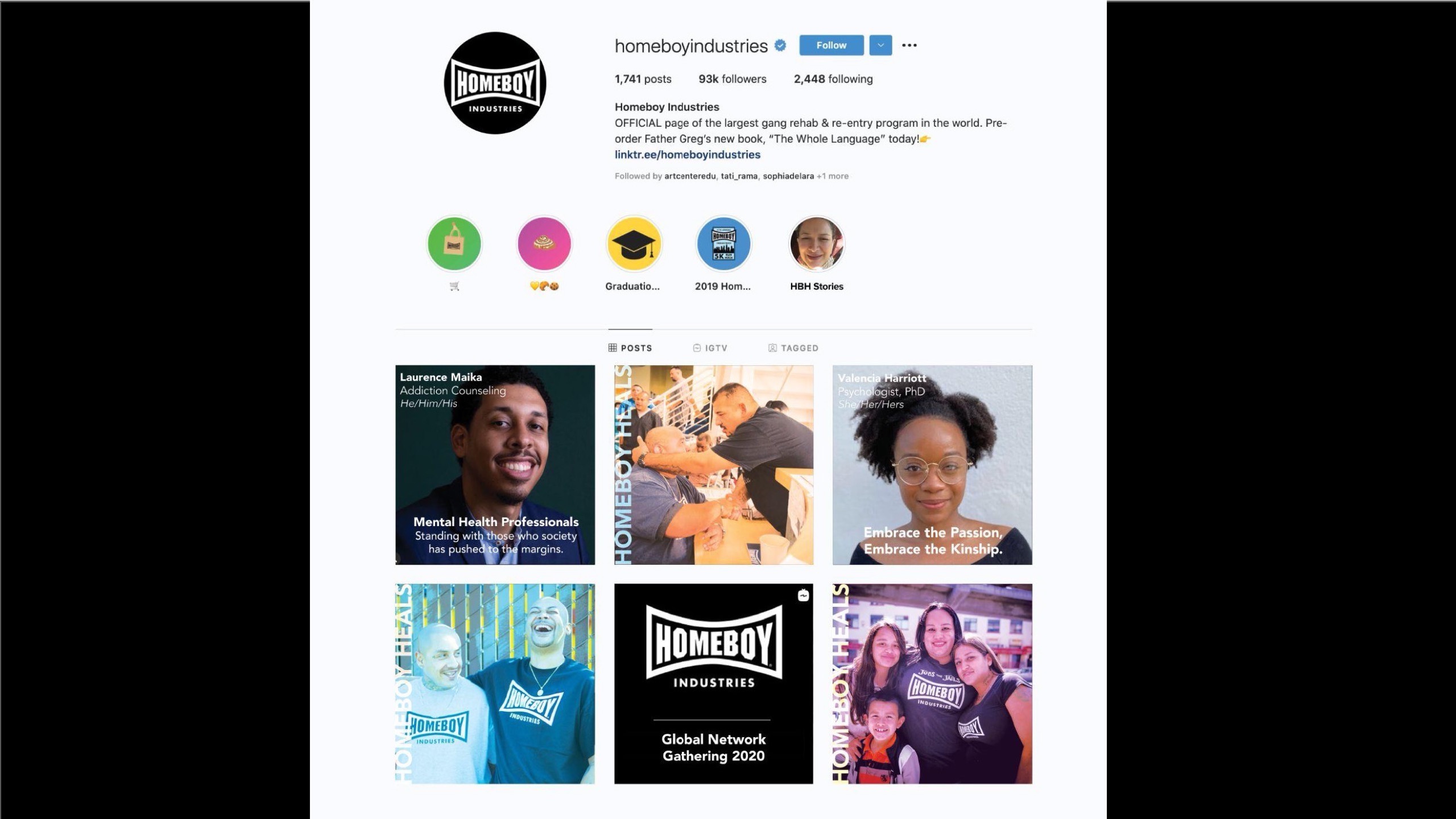 close
close
Team Vigilante
Read moreJonathan Kim, Xun Liu, Linley Regalado
Leveraging Homeboy’s large social media following, this campaign involves creating brand awareness for Homeboy Heals through video and social media content that directly relates to mental health. Creating brand awareness through mental health issues could set the stage for experienced therapists to sign up to volunteer at Homeboy Heals.
Energetic posters describing Homeboy Heals would be distributed at medical centers and places of higher education (UCLA) as well as on street banners.
Simple one-minute videos would interview a Homeboy therapist about their volunteering, asking them #HowAreYouFeeling? These honest human interactions would show the position in a positive, realistic environment.
Additionally, Homeboy Heals could host a livestream event/talk that would target mental health professionals. This webinar would feature personal stories from Homeboy therapists about their role, what fulfills them about the gig and how volunteering has augmented their practice. Hosted by Eventbrite or Meetup, the webinar would welcome participant questions and include a live Twitter feed. Afterward, participants would receive a thank-you emails and a short survey. The livestream can also be uploaded on YouTube for further viewing.
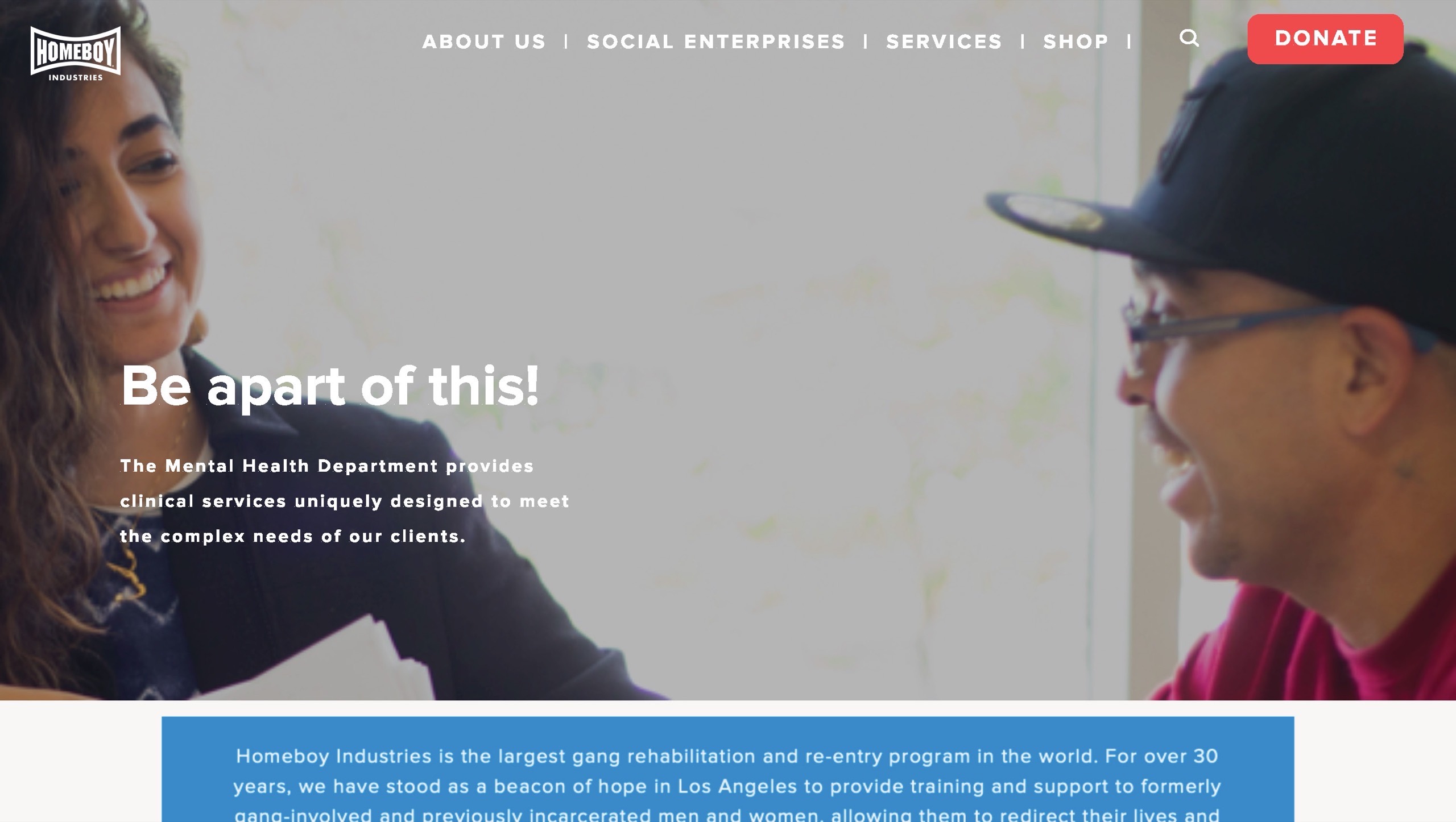 close
close
Team Amigas
Read moreAnnie Chen, Dominque Rivero
This campaign incorporates three distinct areas of brand awareness opportunities of the Homeboy Heals program to connect to professionals but also those with a Lived Experience who can be instrumental in the program.
A Homeboy Heals Brand Identity Guide would feature brand values and an open door motif, logos (influenced by the well-known Homeboy logo), a color palette and a series of possible taglines: “A door that’s always open,” and “A space for all.”
A Day in the Life video would turn the camera lens on the therapist who honestly will reflect on their work at Homeboy in an authentic and down-to-earth method. These 2-5 minute video would show volunteering as rewarding. Videos can run on social media platforms with new installments can be introduced every 4-5 months.
Finally, a revamped website presence for Homeboy Heals would connect to the main Homeboy Industries website. Anchored with the three categories of Stand, Heal and Invest, the website will highlight the Day in the Life videos along with zine/publication content. A reimagined volunteer application form streamlines the process for those interested. Volunteer responsibilities will be spelled out to avoid confusion.
